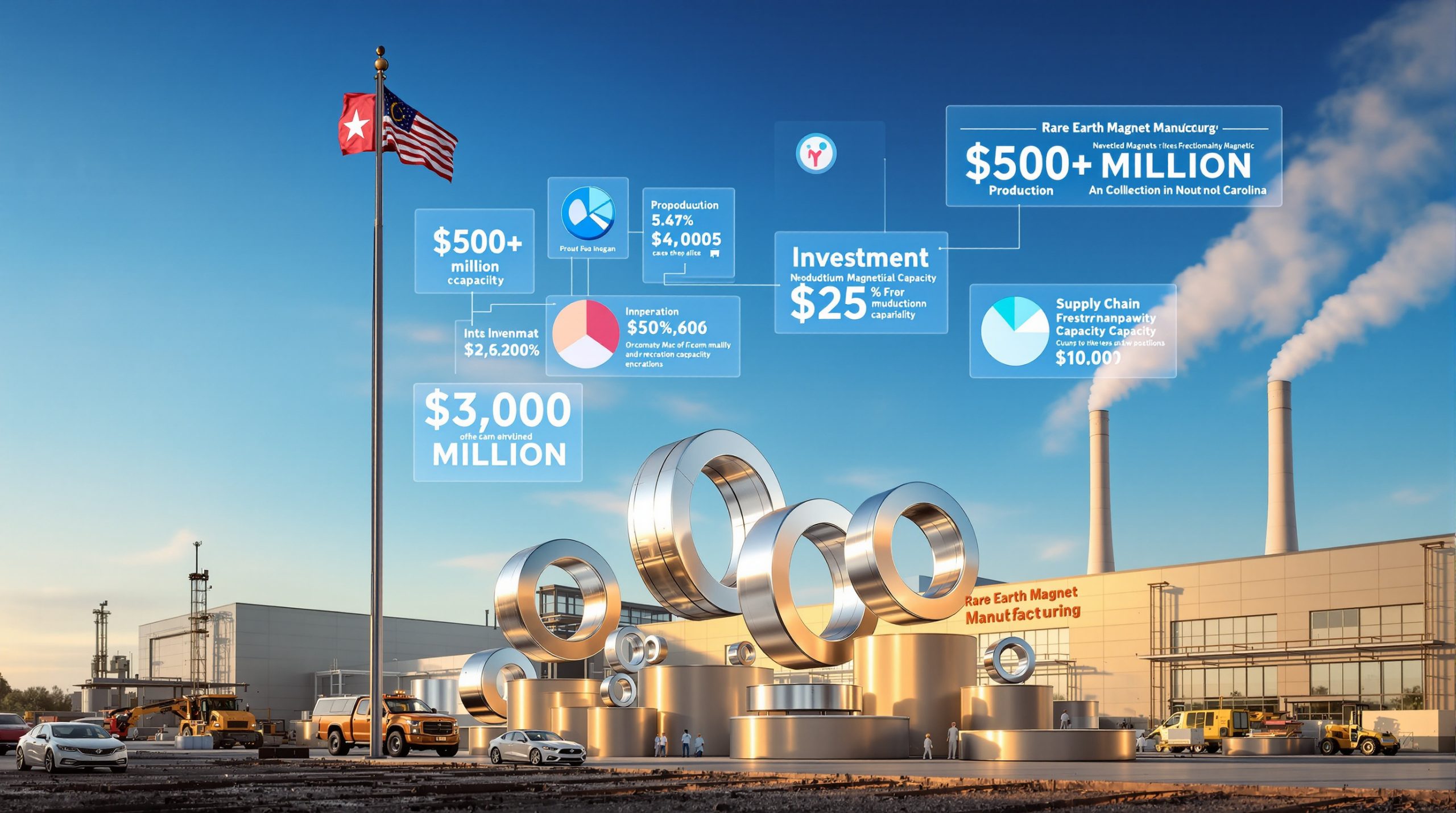Understanding the Strategic Shift Toward Domestic HREE Manufacturing
MP Materials has positioned itself at the forefront of America's critical minerals independence through an ambitious transformation from traditional mining operations into comprehensive rare earth processing capabilities. The MP Materials heavy rare earth production initiative represents a fundamental restructuring of domestic supply chain strategy, targeting complete independence from foreign dependencies in critical elements essential for energy transition security.
The initiative focuses on establishing domestic production capabilities for dysprosium and terbium, two essential elements required for high-performance permanent magnets used in electric vehicles, wind turbines, and defence applications. This strategic pivot addresses longstanding vulnerabilities in America's industrial base while capitalising on the Mountain Pass mine's unique geological characteristics.
The SEG+ Feedstock Foundation
MP Materials has developed a proprietary feedstock called SEG+ (Separated Heavy Rare Earth Group Plus), which contains approximately 4% dysprosium and terbium by total rare earth oxide weight. Since late 2023, the company has systematically accumulated over 200 metric tons of this specialised material, creating a substantial inventory buffer for initial processing operations.
This feedstock represents a critical breakthrough in domestic heavy rare earth supply chain development. The SEG+ material originates from the Mountain Pass mine's unique geological formations, where specific processing techniques can concentrate heavy rare earth elements that are typically found in much lower concentrations in most deposits worldwide.
Processing Yield and Quality Specifications
The challenge lies in converting the 4% Dy+Tb concentration in SEG+ feedstock into magnet-grade purity levels suitable for downstream manufacturing. This conversion requires sophisticated processing techniques that must demonstrate reliable yield rates while maintaining consistent quality standards across multiple production cycles.
Key Processing Challenges:
- Multi-stage solvent extraction processes
- Ion-exchange purification systems
- Quality control for magnet-grade specifications
- Process yield optimisation for economic viability
Refinery Infrastructure and Production Targets
The planned heavy rare earth refinery will target 200 metric tons per year of combined dysprosium and terbium production, specifically designed to support 10,000 metric tons of neodymium-iron-boron (NdFeB) magnet manufacturing capacity. This processing volume represents a carefully calculated balance between domestic demand requirements and operational feasibility.
MP Materials' Chief Communications Officer has confirmed that the company plans to begin commissioning its HREE refinery by mid-2026, establishing the timeline for America's first significant domestic heavy rare earth processing capability. This timeline positions the initiative as a critical component of national supply chain security, furthermore supporting broader sustainable mining practices across the industry.
Technical Integration with Magnet Production
The heavy rare earth production directly supports MP Materials' broader "10X" initiative, which aims to establish a complete mine-to-magnet supply chain on U.S. soil. The integration between HREE processing and downstream magnet manufacturing in Texas represents an unprecedented level of vertical integration in the American rare earth industry.
Production Specifications:
| Component | Target Output | Application |
|---|---|---|
| Dysprosium + Terbium | 200 MT annually | High-performance magnets |
| NdFeB Magnet Support | 10,000 MT capacity | EV motors, wind turbines |
| Processing Timeline | Mid-2026 commissioning | National security applications |
Department of Defense Partnership Structure
The U.S. Department of Defense has established comprehensive support for MP Materials' HREE initiative through both financial backing and strategic ownership participation. This partnership reflects the critical national security implications of establishing domestic rare earth processing capabilities independent of foreign supply chains.
The $150 million DoD loan facility provides essential capital for refinery construction and equipment procurement, while the 15% DoD ownership stake ensures government involvement in strategic decision-making processes. Additionally, this public-private partnership demonstrates the Pentagon's commitment to accelerating U.S. rare earth independence, creating alignment between commercial objectives and national security priorities.
Strategic Supply Chain Guarantees
Government support extends beyond financial backing to include long-term procurement commitments that provide revenue stability during initial production phases. These guarantees address market uncertainties that typically challenge new domestic processing capabilities competing against established foreign suppliers.
Government Support Components:
- $150 million DoD loan facility
- 15% DoD ownership stake in MP Materials
- Long-term procurement commitments
- Strategic supply chain security guarantees
Apple Partnership and Recycling Integration
MP Materials has secured a $500 million partnership with Apple to develop an advanced recycling facility that will recover both light and heavy rare earths from end-of-life electronic products. Apple has already transferred the first payment toward this comprehensive recycling effort, demonstrating concrete commitment to the initiative.
This closed-loop approach represents a significant advancement in sustainable rare earth supply chain management, creating a self-reinforcing supply system where processed materials can be continuously recovered and reprocessed. In addition, the recycling facility will provide feedstock containing both light and heavy rare earth elements, reducing dependence on primary mining operations whilst supporting the battery recycling breakthrough trends emerging globally.
Circular Economy Implementation
The recycling component creates multiple strategic advantages beyond simple material recovery. By establishing domestic recycling capabilities, the initiative reduces environmental impact compared to primary extraction while enhancing supply chain resilience through diversified feedstock sources.
Recycling Facility Benefits:
- Recovery of both LREEs and HREEs from consumer electronics
- Reduced environmental impact compared to primary extraction
- Enhanced supply chain resilience through diversified feedstock sources
- Integration with existing Mountain Pass operations
Processing Complexity and Technical Challenges
Heavy rare earth separation requires significantly more sophisticated processing techniques compared to light rare earth extraction. The chemical similarities between dysprosium and terbium create separation challenges that demand advanced solvent extraction and ion-exchange technologies operating at industrial scale.
The transition from stockpiled feedstock to fully operational heavy rare earth separation represents a substantial technical leap. Industry experts suggest that complete onshoring of HREE separation capabilities may require 5-7 years to achieve full commercial reliability, highlighting the ambitious nature of MP Materials' mid-2026 timeline.
Yield Optimisation Strategies
Achieving consistent magnet-grade purity levels from the 4% Dy+Tb concentration in SEG+ feedstock requires precise process control across multiple purification stages. The company must demonstrate reliable conversion rates that justify the economic investment while meeting stringent quality specifications for downstream applications.
Industry Insight: Grain-boundary-diffusion (GBD) and other thrifting technologies are reducing HREE intensity in high-performance magnets, providing MP Materials with valuable flexibility as processing capabilities scale.
Third-Party Feedstock Integration Strategy
Beyond internal SEG+ production, MP Materials is actively negotiating agreements with multiple third-party feedstock suppliers to enhance processing volume and reduce supply chain risks. Company communications indicate active engagement with several potential sources, with plans to integrate multiple suppliers over time.
This diversified supply approach allows the company to leverage external rare earth concentrates while maintaining operational flexibility. However, the strategy addresses potential bottlenecks in domestic feedstock availability while optimising processing economics through blended material streams, reflecting modern mine planning approaches that prioritise supply chain resilience.
Missouri's Pea Ridge Mine Potential
The Pea Ridge iron-oxide-apatite deposit in Washington County, Missouri represents a significant potential domestic feedstock source. Research indicates that breccia pipe samples contain approximately 20% rare earth oxide content with notable heavy rare earth concentrations, including dysprosium and terbium.
The Pea Ridge deposit, owned by Caldera Holding LLC, offers compelling geological characteristics that could substantially boost domestic HREE feedstock availability. The site has purportedly licensed commercial separation technology, though development timelines and permitting requirements remain under evaluation.
Pea Ridge Mine Characteristics:
- Average ~20 wt% REO content in breccia-pipe samples
- Significant heavy rare earth presence including Dy+Tb
- Existing commercial separation technology licences
- Potential backup feedstock for national supply security
Timeline Risks and Execution Challenges
The complexity of HREE separation technology creates inherent risks in equipment commissioning and process optimisation. Technical delays in refinery construction or processing system integration could impact the projected mid-2026 operational timeline, particularly given the sophisticated nature of heavy rare earth purification processes.
Independent industry commentary suggests that while MP Materials is making meaningful progress, the timeline remains ambitious considering the technical challenges involved. Consequently, the step from feedstock accumulation to fully commercial heavy rare earth separation requires demonstration of consistent processing yields at commercial scale.
Regulatory and Permitting Considerations
Environmental permitting for rare earth processing facilities involves extensive regulatory review processes that can extend project timelines. Additional compliance requirements or environmental impact assessments could affect commissioning schedules, particularly for novel processing technologies.
Potential Risk Factors:
- Equipment delivery and installation delays
- Process optimisation and testing periods
- Regulatory approval timelines
- Skilled workforce availability
- Supply chain disruptions for construction materials
Global Competitive Context
China currently controls approximately 90% of global heavy rare earth separation and processing capabilities, creating a significant competitive benchmark for MP Materials' initiative. The company's 200 metric ton annual target represents a meaningful but modest contribution to global HREE supply, focusing on strategic rather than commodity market positioning.
MP Materials' initiative positions the company as a critical supplier for Western manufacturers seeking to reduce dependence on Chinese rare earth sources. This strategic positioning could command premium pricing while serving growing demand from electric vehicle and renewable energy sectors prioritising supply chain security, furthermore supporting industry innovation trends across the sector.
Strategic Supply Chain Positioning
The initiative addresses a critical gap in Western rare earth supply chains, where technical expertise and processing infrastructure have remained concentrated in Asia. By establishing domestic capabilities, MP Materials creates optionality for manufacturers facing geopolitical supply chain risks, supported by ongoing U.S. rare earth policy analysis from leading research institutions.
Global HREE Production Landscape:
| Region | Current Capacity | Strategic Significance |
|---|---|---|
| China | ~90% of global HREE supply | Dominant market position |
| United States | Minimal domestic capacity | National security priority |
| Australia/Canada | Limited processing capability | Allied supply chain development |
Economic Drivers and Market Viability
Growing demand for high-performance permanent magnets in electric vehicles, wind turbines, and defence applications creates favourable market conditions for domestic HREE production. The initiative targets this expanding market while offering supply chain security premiums that justify higher production costs compared to established foreign suppliers.
Market dynamics favour supply chain diversification as manufacturers increasingly value reliability and geopolitical stability over pure cost optimisation. Government procurement commitments provide additional revenue stability during the initial commercialisation phase.
Cost Structure and Competitive Positioning
While domestic HREE production may initially carry higher costs compared to Chinese suppliers, the strategic value of supply chain security and reduced geopolitical risks provides economic justification for premium pricing structures. Long-term price stability benefits and reduced transportation costs further support the business case.
Economic Justification Factors:
- Growing EV and renewable energy demand
- Supply chain security premiums
- Government procurement commitments
- Long-term price stability benefits
- Reduced transportation and logistics costs
Success Metrics and Validation Framework
Success metrics for the MP Materials heavy rare earth production initiative will include achieving consistent 200 metric ton annual production rates while maintaining magnet-grade purity specifications for dysprosium and terbium output. Quality consistency will be crucial for downstream magnet manufacturing operations and customer qualification processes.
The initiative's ultimate success depends on seamless integration with MP Materials' planned 10,000 metric ton magnet manufacturing capacity in Texas, demonstrating complete mine-to-magnet supply chain functionality. For instance, this integration represents an unprecedented level of vertical coordination in the American rare earth industry.
Supply Chain Integration Effectiveness
Validation will require demonstration of reliable material flows from Mountain Pass processing through heavy rare earth separation to final magnet production. Each stage must meet quality and volume specifications while maintaining economic competitiveness against established supply chains.
Key Performance Indicators:
- Monthly production target achievement
- Magnet-grade purity consistency
- Customer qualification approvals
- Processing cost competitiveness
- Supply chain reliability demonstrations
Disclaimer: This analysis contains forward-looking projections and industry speculation that involve inherent uncertainties. Rare earth processing timelines and technical achievements may vary significantly from stated targets. Investment decisions should consider the speculative nature of emerging domestic processing capabilities and established global supply chain alternatives.
Ready to Capitalise on Critical Minerals Investment Opportunities?
Discovery Alert's proprietary Discovery IQ model delivers real-time notifications on significant ASX mineral discoveries, including critical minerals essential for energy transition and national security priorities. Begin your 30-day free trial today to position yourself ahead of the market and discover why major mineral discoveries can deliver substantial returns for informed investors.




